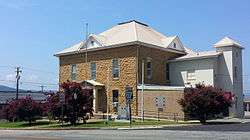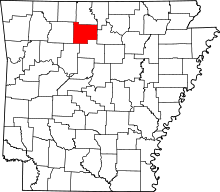Marshall, Arkansas
| Marshall, Arkansas | |
|---|---|
| City | |
|
Searcy County Courthouse in downtown Marshall | |
 Location in Searcy County and the state of Arkansas | |
| Coordinates: 35°54′36″N 92°38′11″W / 35.91000°N 92.63639°WCoordinates: 35°54′36″N 92°38′11″W / 35.91000°N 92.63639°W | |
| Country | United States |
| State | Arkansas |
| County | Searcy |
| Government | |
| • Mayor | Kevin Elliott |
| Area | |
| • Total | 2.6 sq mi (6.7 km2) |
| • Land | 2.6 sq mi (6.7 km2) |
| • Water | 0 sq mi (0 km2) |
| Elevation | 1,040 ft (317 m) |
| Population (2010) | |
| • Total | 1,355 |
| • Density | 505/sq mi (196/km2) |
| Time zone | Central (CST) (UTC-6) |
| • Summer (DST) | CDT (UTC-5) |
| ZIP code | 72650 |
| Area code(s) | 870 |
| FIPS code | 05-44300 |
| GNIS feature ID | 0077601 |
Marshall is a city in Searcy County, Arkansas, United States. The population was 1,355 at the 2010 census. The city is the county seat of Searcy County.[1] Marshall was incorporated in 1884. Prior to the American Civil War, Marshall was known as Burrowsville.[2]
Geography
Marshall is located at 35°54′36″N 92°38′11″W / 35.909950°N 92.636370°W.[3]
According to the United States Census Bureau, the city has a total area of 2.6 square miles (6.7 km2), all of it land.
Major Highways
Demographics
| Historical population | |||
|---|---|---|---|
| Census | Pop. | %± | |
| 1880 | 160 | — | |
| 1890 | 278 | 73.8% | |
| 1900 | 260 | −6.5% | |
| 1910 | 558 | 114.6% | |
| 1920 | 749 | 34.2% | |
| 1930 | 638 | −14.8% | |
| 1940 | 822 | 28.8% | |
| 1950 | 1,189 | 44.6% | |
| 1960 | 1,095 | −7.9% | |
| 1970 | 1,397 | 27.6% | |
| 1980 | 1,595 | 14.2% | |
| 1990 | 1,318 | −17.4% | |
| 2000 | 1,313 | −0.4% | |
| 2010 | 1,355 | 3.2% | |
| Est. 2015 | 1,300 | [4] | −4.1% |
As of the census[6] of 2000, there were 1,313 people, 594 households, and 355 families residing in the city. The population density was 506.1 people per square mile (195.7/km²). There were 712 housing units at an average density of 274.4 per square mile (106.1/km²). The racial makeup of the city was 98.32% White, 0.08% Black or African American, 1.30% Native American, 0.30% from other races, and 0.99% from two or more races. 0.99% of the population were Hispanic or Latino of any race.
There were 594 households out of which 24.7% had children under the age of 18 living with them, 46.0% were married couples living together, 11.4% had a female householder with no husband present, and 40.2% were non-families. 39.1% of all households were made up of individuals and 23.6% had someone living alone who was 65 years of age or older. The average household size was 2.12 and the average family size was 2.81.
In the city the population was spread out with 21.7% under the age of 18, 8.1% from 18 to 24, 21.9% from 25 to 44, 19.0% from 45 to 64, and 29.2% who were 65 years of age or older. The median age was 44 years. For every 100 females there were 80.1 males. For every 100 females age 18 and over, there were 74.5 males.
The median income for a household in the city was $18,846, and the median income for a family was $27,500. Males had a median income of $22,857 versus $14,107 for females. The per capita income for the city was $13,772. About 20.0% of families and 27.5% of the population were below the poverty line, including 38.4% of those under age 18 and 25.7% of those age 65 or over.
History
The community was named for John Marshall, chief justice of the U.S. Supreme Court. Although Marshall was mostly destroyed during the Civil War, it grew during the nineteenth century. The Missouri and North Arkansas Railroad sped the growth of the town during the early twentieth century. However, the post-World War I slump hit the area economies hard, causing an effect well known to other parts of the country.
Education

Public education for elementary and secondary school students is available from the Searcy County School District, including Marshall High School. Marshall High's mascot is the bobcat. The Marshall High girls basketball team won back-to-back Class AAA state championships in 2007 and 2008.[7]
Climate
The climate in this area is characterized by hot, humid summers and generally mild to cool winters. According to the Köppen Climate Classification system, Marshall has a humid subtropical climate, abbreviated "Cfa" on climate maps.[8]
Notable people
- David Branscum - Republican member of the Arkansas House of Representatives from Searcy County since 2011
- Elton Britt - Western music yodeler.
- Jim L. Smithson - Republican state legislator from Searcy County from 1975 to 1984. A pharmacist, he worked to obtain generic drugs as a substitute for prescription medications when feasible. He was elected mayor of Marshall in 2010.
References
- ↑ "Find a County". National Association of Counties. Retrieved 2011-06-07.
- ↑ http://www.encyclopediaofarkansas.net/encyclopedia/entry-detail.aspx?entryID=986 Retrieved 2013-07-15.
- ↑ "US Gazetteer files: 2010, 2000, and 1990". United States Census Bureau. 2011-02-12. Retrieved 2011-04-23.
- ↑ "Annual Estimates of the Resident Population for Incorporated Places: April 1, 2010 to July 1, 2015". Retrieved July 2, 2016.
- ↑ "Census of Population and Housing". Census.gov. Retrieved June 4, 2015.
- ↑ "American FactFinder". United States Census Bureau. Retrieved 2008-01-31.
- ↑ School District Reference Map (2010 Census) Searcy County, AR (PDF) (Map). US Census Bureau. Retrieved 2011-07-12.
- ↑ Climate Summary for Marshall, Arkansas
External links
- Marshall (Searcy County). Encyclopedia of Arkansas History and Culture.
- Map of Marshall (US Census Bureau)
- Map of Searcy County (US Census Bureau)
- Marshall entry in Encyclopedia of Arkansas
- Searcy County School District
- Searcy County Historical Society


